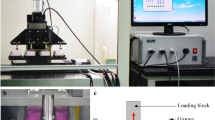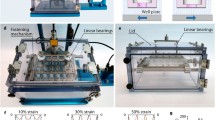Abstract
Mechanical stimulation of engineered cartilage constructs is a commonly applied method used to accelerate tissue formation and improve the mechanical properties of the developed tissue. While the effects of compression and shear have been widely studied, the effect of tension has received relatively little attention. As articular cartilage in vivo is subjected to a degree of static tension (pre-tension) even in the absence of externally applied loads, the purpose of this study was to investigate the effect of intermittent static biaxial tensile strains (BTS) on chondrocyte metabolism and resultant tissue formation. Using a custom-design loading fixture to apply BTS, the optimal conditions for stimulating extracellular matrix synthesis were under average magnitudes of 3.8% radial and 2.1% circumferential tensile strains for 30 min. Tissue constructs subjected to tensile strain stimulation 3 times/week for a period of 4 weeks displayed increased thickness (35 ± 18%) and proteoglycan content (22 ± 7%) without an associated change in mechanical properties. In contrast, constructs stimulated daily over the same time period exhibited negligible effects in terms of ECM accumulation suggesting that the frequency of stimulation needs to be precisely controlled. The results of this study demonstrate that while tension can be used as potential biomechanical stimulus to improve tissue formation, further optimization of this process needs to be conducted to improve ECM accumulation and tissue mechanical properties after long-term exposure to tensile stimuli.





Similar content being viewed by others
References
Bonassar, L. J., A. J. Grodzinsky, E. H. Frank, S. G. Davila, N. R. Bhaktav, and S. B. Trippel. The effect of dynamic compression on the response of articular cartilage to insulin-like growth factor-I. J. Orthop. Res. 19:11–17, 2001.
Bostrom, H., and B. Mansson. On the enzymatic exchange of the sulfate group of chondroitinsulfuric acid in slices of cartilage. J. Biol. Chem. 196:483–488, 1952.
Boyle, J., B. Luan, T. F. Cruz, and R. A. Kandel. Characterization of proteoglycan accumulation during formation of cartilagenous tissue in vitro. Osteoarthr. Cartil. 3:117–125, 1995.
Buckwalter, J. A., T. A. Einhorn, and S. R. Simon. Orthopaedic basic science: biology and biomechanics of the musculoskeletal system. Am. Acad. Orthop. Surg. 2000.
Buschmann, M. D., Y. A. Gluzband, A. J. Grodzinsky, and E. B. Hunziker. Mechanical compression modulates matrix biosynthesis in chondrocyte/agarose culture. J. Cell Sci. 108(Pt 4):1497–1508, 1995.
Buschmann, M. D., Y. A. Gluzband, A. J. Grodzinsky, J. H. Kimura, and E. B. Hunziker. Chondrocytes in agarose culture synthesize a mechanically functional extracellular matrix. J. Orthop. Res. 10:745–758, 1992.
Chevrier, A., E. Rossomacha, M. D. Buschmann, and C. D. Hoemann. Optimization of histoprocessing methods to detect glycosaminoglycan, collagen type II, and collagen type I in decalcified rabbit osteochondral sections. J. Histotechnol. 28:165–175, 2005.
Connelly, J. T., E. J. Vanderploeg, and M. E. Levenston. The influence of cyclic tension amplitude on chondrocyte matrix synthesis: experimental and finite element analyses. Biorheology 41:377–387, 2004.
De Croos, J. N., S. S. Dhaliwal, M. D. Grynpas, R. M. Pilliar, and R. A. Kandel. Cyclic compressive mechanical stimulation induces sequential catabolic and anabolic gene changes in chondrocytes resulting in increased extracellular matrix accumulation. Matrix Biol. 25:323–331, 2006.
Farndale, R. W., D. J. Buttle, and A. J. Barrett. Improved quantitation and discrimination of sulphated glycosaminoglycans by use of dimethylmethylene blue. Biochim. Biophys. Acta 883:173–177, 1986.
Fry, H. J. The interlocked stresses of articular cartilage. Br. J. Plast. Surg. 27:363–364, 1974.
GEHR Plastics, I. Technical data sheet: acrylnitrile butadiene styrene copolymer, 2008.
Gibson, T., and W. B. Davis. The distortion of autogenous cartilage grafts: its cause and prevention. Br. J. Plast. Surg. 10:257–274, 1958.
Goldberg, R. L., and L. M. Kolibas. An improved method for determining proteoglycans synthesized by chondrocytes in culture. Connect. Tissue Res. 24:265–275, 1990.
Goodfellow. Polytetrafluoroethylene (PTFE) material information, 2008.
Goodfellow. Technical information—polyacrylonitrile-butadiene-styrene, 2008.
Hayes, W. C., L. M. Keer, G. Herrmann, and L. F. Mockros. A mathematical analysis for indentation tests of articular cartilage. J. Biomech. 5:541–551, 1972.
Heinegard, D., M. Bayliss, and P. Lorenzo. Biochemistry and metabolism of normal and osteoarthritic cartilage. In: Osteoarthritis, edited by K. D. Brandt, M. Doherty, and L. S. Lohmander. New York: Oxford University Press, 1998, pp. 74–84.
Hirano, Y., N. Ishiguro, M. Sokabe, M. Takigawa, and K. Naruse. Effects of tensile and compressive strains on response of a chondrocytic cell line embedded in type I collagen gel. J. Biotechnol. 133:245–252, 2008.
Hoch, D. H., A. J. Grodzinsky, T. J. Koob, M. L. Albert, and D. R. Eyre. Early changes in material properties of rabbit articular cartilage after meniscectomy. J. Orthop. Res. 1:4–12, 1983.
Honda, K., S. Ohno, K. Tanimoto, C. Ijuin, N. Tanaka, T. Doi, Y. Kato, and K. Tanne. The effects of high magnitude cyclic tensile load on cartilage matrix metabolism in cultured chondrocytes. Eur. J. Cell Biol. 79:601–609, 2000.
Huang, J., L. R. Ballou, and K. A. Hasty. Cyclic equibiaxial tensile strain induces both anabolic and catabolic responses in articular chondrocytes. Gene 404:101–109, 2007.
Hunziker, E. B. Articular cartilage repair: basic science and clinical progress. A review of the current status and prospects. Osteoarthr. Cartil. 10:432–463, 2002.
Ikenoue, T., M. C. Trindade, M. S. Lee, E. Y. Lin, D. J. Schurman, S. B. Goodman, and R. L. Smith. Mechanoregulation of human articular chondrocyte aggrecan and type II collagen expression by intermittent hydrostatic pressure in vitro. J. Orthop. Res. 21:110–116, 2003.
Jin, M., E. H. Frank, T. M. Quinn, E. B. Hunziker, and A. J. Grodzinsky. Tissue shear deformation stimulates proteoglycan and protein biosynthesis in bovine cartilage explants. Arch. Biochem. Biophys. 395:41–48, 2001.
Kaupp, J. A., and S. D. Waldman. Mechanical vibrations increase the proliferation of articular chondrocytes in high-density culture. Proc. Inst. Mech. Eng. [H] 222:695–703, 2008.
Khan, A. A., J. M. Suits, R. A. Kandel, and S. D. Waldman. The effect of continuous culture on the growth and structure of tissue-engineered cartilage. Biotechnol. Prog. 25:508–515, 2009.
Kim, Y. J., R. L. Sah, J. Y. Doong, and A. J. Grodzinsky. Fluorometric assay of DNA in cartilage explants using Hoechst 33258. Anal. Biochem. 174:168–176, 1988.
Kisiday, J. D., M. Jin, M. A. DiMicco, B. Kurz, and A. J. Grodzinsky. Effects of dynamic compressive loading on chondrocyte biosynthesis in self-assembling peptide scaffolds. J. Biomech. 37:595–604, 2004.
Lai, W. M., J. S. Hou, and V. C. Mow. A triphasic theory for the swelling and deformation behaviors of articular cartilage. J. Biomech. Eng. 113:245–258, 1991.
Leblond, C. P., B. Messier, and B. Kopriwa. Thymidine-H3 as a tool for the investigation of the renewal of cell populations. Lab. Invest. 8:296–306, 1959; discussion 306–308.
Lee, D. A., T. Noguchi, S. P. Frean, P. Lees, and D. L. Bader. The influence of mechanical loading on isolated chondrocytes seeded in agarose constructs. Biorheology 37:149–161, 2000.
Maroudas, A., and M. Venn. Chemical composition and swelling of normal and osteoarthrotic femoral head cartilage. II. Swelling. Ann. Rheum. Dis. 36:399–406, 1977.
Martin, I., B. Obradovic, S. Treppo, A. J. Grodzinsky, R. Langer, L. E. Freed, and G. Vunjak-Novakovic. Modulation of the mechanical properties of tissue engineered cartilage. Biorheology 37:141–147, 2000.
Mauck, R. L., M. A. Soltz, C. C. Wang, D. D. Wong, P. H. Chao, W. B. Valhmu, C. T. Hung, and G. A. Ateshian. Functional tissue engineering of articular cartilage through dynamic loading of chondrocyte-seeded agarose gels. J. Biomech. Eng. 122:252–260, 2000.
Millipore Corporation. Millicell® Culture Plate Inserts 1–6, 2004.
Narmoneva, D. A., J. Y. Wang, and L. A. Setton. Nonuniform swelling-induced residual strains in articular cartilage. J. Biomech. 32:401–408, 1999.
Newman, A. P. Articular cartilage repair. Am. J. Sports Med. 26:309–324, 1998.
Parker-TexLoc. PTFE detailed properties (polytetrafluoroethylene), 2008.
Peterkofsky, B., and R. Diegelmann. Use of a mixture of proteinase-free collagenases for the specific assay of radioactive collagen in the presence of other proteins. Biochemistry 10:988–994, 1971.
Quinn, T. M., A. J. Grodzinsky, M. D. Buschmann, Y. J. Kim, and E. B. Hunziker. Mechanical compression alters proteoglycan deposition and matrix deformation around individual cells in cartilage explants. J. Cell Sci. 111(Pt 5):573–583, 1998.
Ramakrishnan, N., and V. S. Arunachalam. Effective elastic moduli of porous solids. J. Mater. Sci. Mater. Med. 25:3930–3937, 1990.
Saxon, L. K., A. G. Robling, I. Alam, and C. H. Turner. Mechanosensitivity of the rat skeleton decreases after a long period of loading, but is improved with time off. Bone 36:454–464, 2005.
Schriefer, J. L., S. J. Warden, L. K. Saxon, A. G. Robling, and C. H. Turner. Cellular accommodation and the response of bone to mechanical loading. J. Biomech. 38:1838–1845, 2005.
Stratasys Inc. ABS, 2007.
Tare, R. S., D. Howard, J. C. Pound, H. I. Roach, and R. O. Oreffo. Tissue engineering strategies for cartilage generation—micromass and three dimensional cultures using human chondrocytes and a continuous cell line. Biochem. Biophys. Res. Commun. 333:609–621, 2005.
Turner, C. H. Three rules for bone adaptation to mechanical stimuli. Bone 23:399–407, 1998.
Vanderploeg, E. J., S. M. Imler, K. R. Brodkin, A. J. Garcia, and M. E. Levenston. Oscillatory tension differentially modulates matrix metabolism and cytoskeletal organization in chondrocytes and fibrochondrocytes. J. Biomech. 37:1941–1952, 2004.
Vanderploeg, E. J., C. G. Wilson, and M. E. Levenston. Articular chondrocytes derived from distinct tissue zones differentially respond to in vitro oscillatory tensile loading. Osteoarthr. Cartil. 16:1228–1236, 2008.
Vunjak-Novakovic, G., I. Martin, B. Obradovic, S. Treppo, A. J. Grodzinsky, R. Langer, and L. E. Freed. Bioreactor cultivation conditions modulate the composition and mechanical properties of tissue-engineered cartilage. J. Orthop. Res. 17:130–138, 1999.
Waldman, S. D., D. C. Couto, S. J. Omelon, and R. A. Kandel. Effect of sodium bicarbonate on extracellular pH, matrix accumulation, and morphology of cultured articular chondrocytes. Tissue Eng. 10:1633–1640, 2004.
Waldman, S. D., M. D. Grynpas, R. M. Pilliar, and R. A. Kandel. Characterization of cartilagenous tissue formed on calcium polyphosphate substrates in vitro. J. Biomed. Mater. Res. 62:323–330, 2002.
Waldman, S. D., C. G. Spiteri, M. D. Grynpas, R. M. Pilliar, J. Hong, and R. A. Kandel. Effect of biomechanical conditioning on cartilaginous tissue formation in vitro. J. Bone Joint Surg. Am. 85-A(Suppl 2):101–105, 2003.
Waldman, S. D., C. G. Spiteri, M. D. Grynpas, R. M. Pilliar, and R. A. Kandel. Long-term intermittent compressive stimulation improves the composition and mechanical properties of tissue-engineered cartilage. Tissue Eng. 10:1323–1331, 2004.
Waldman, S. D., C. G. Spiteri, M. D. Grynpas, R. M. Pilliar, and R. A. Kandel. Long-term intermittent shear deformation improves the quality of cartilaginous tissue formed in vitro. J. Orthop. Res. 21:590–596, 2003.
Wilkins, R. J., and A. C. Hall. Control of matrix synthesis in isolated bovine chondrocytes by extracellular and intracellular pH. J. Cell. Physiol. 164:474–481, 1995.
Woessner, Jr., J. F. The determination of hydroxyproline in tissue and protein samples containing small proportions of this imino acid. Arch. Biochem. Biophys. 93:440–447, 1961.
Wong, M., M. Siegrist, and K. Goodwin. Cyclic tensile strain and cyclic hydrostatic pressure differentially regulate expression of hypertrophic markers in primary chondrocytes. Bone 33:685–693, 2003.
Zhang, Z., J. M. McCaffery, R. G. Spencer, and C. A. Francomano. Hyaline cartilage engineered by chondrocytes in pellet culture: histological, immunohistochemical and ultrastructural analysis in comparison with cartilage explants. J. Anat. 205:229–237, 2004.
Acknowledgments
Funding for this work was provided by the Natural Sciences and Engineering Research Council (NSERC) of Canada. The authors would like to thank Mr. John DaCosta (Department of Pathology and Laboratory Medicine) and Ms. Aasma Khan (Department of Chemical Engineering) for their technical assistance in the histological and immunohistochemical analyses.
Author information
Authors and Affiliations
Corresponding author
Additional information
Associate Editor Sean S. Kohles oversaw the review of this article.
Rights and permissions
About this article
Cite this article
Fan, J.C.Y., Waldman, S.D. The Effect of Intermittent Static Biaxial Tensile Strains on Tissue Engineered Cartilage. Ann Biomed Eng 38, 1672–1682 (2010). https://doi.org/10.1007/s10439-010-9917-5
Received:
Accepted:
Published:
Issue Date:
DOI: https://doi.org/10.1007/s10439-010-9917-5




